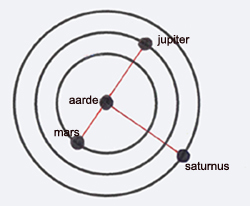Planetary meanings
as exponents of the Earth
18.3
page 3 of 5
The outer planets
The three outer planets, Saturn, Jupiter and Mars, present a different picture. Within their orbits around the Sun, they in turn encompass Earth’s orbit as well as that of the inner planets; this gives them a dominant position.
Standing on Earth, we see these each of these three planets moving along their orbit at their own speed; their positions are unrelated to each other, so as a group, they do not form an interconnected whole. This implies that their influence differs substantially from that of the inner planets. Because of their independent position, they can end up in discordant relationships to each other. In figure 18.3.1 (here below), Jupiter and Mars are opposite one another, with Earth in between. Seen from the Sun, there is no opposition here, but seen from Earth, there is. From an astrological perspective, Earth will experience the tension of this opposition in this example.
Moreover, Saturn bridges this opposition through a square aspect, hindering a smooth diversion of the tension. This lends an extra charge to this constellation, which may also take the form of a charged potential.

figure 18.3.1 The outer planets in conflict, as seen from Earth
Because these three are the only planets that can be seen at night with the naked eye, they have traditionally been associated with the night sky. As a group, they are also called the ‘Ich’.
In their relative position to Earth, we can now recognize and further differentiate the basic meanings of both planet groups: the inner planets stand for unity and unification whereas the outer planets stand for dis-union, differentiation and separation.
Full Moon
An important addition to this concept is the position of the Moon in relation to both of these planet groups.
At full moon, the Moon is opposite the Sun (*). Since Earth is positioned between the two, the illuminated face of the Moon is fully facing Earth. The full Moon is even capable of lighting the night sky, dominating the whole scene.
 figure 18.3.2 Full Moon
figure 18.3.2 Full Moon
The three outer planets are now able to line up behind the Moon’s position; in that case, the intermediate, inserted Moon will transfer their charge to Earth, as it were.
New Moon
But the Moon can also be siding with Earth. In that case, Sun and Moon are both found on the same side of Earth, with the sunrays lighting the backside of Moon, invisible to us. This we call New Moon. At New Moon, the Moon appears to us as merely a thin sickle, not dominating the sky at all. Together with the inner planets, she moves along the day sky, where she is hardly noticeable or even visible because of the light of the Sun. We must make an effort to spy her thin halo in the sky.

figure 18.3.3 New Moon
By analogy, the influence of the three inner planets is also less noticeable, less obtrusive. They turn up at the hidden side of the Moon and affect us simultaneously as a group. Their influence calls forth an entire inner interconnection and therefore has a deeper and more lasting effect.
Mirrored by phases of the Moon
So both planet groups are mirrored by the phases of the Moon and through her, they interaction can work out in both polarizing and complementing ways.
This concludes our first classification of these two planet groups based on their orbits on either side of Earth.
index, subjects per page, pictures, blue marked texts, references, tables and overviews, courier, forum